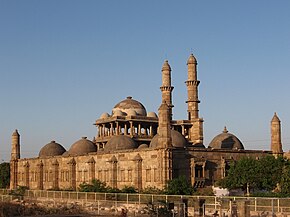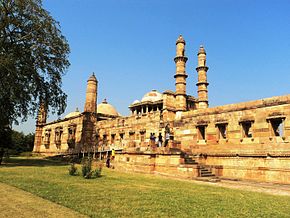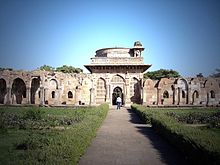Jama Masjid (Champaner)
The Friday mosque ( Jama Masjid ) in the Archaeological Park of Champaner-Pavagadh in the state of Gujarat , recognized by UNESCO as a World Heritage Site , was once one of the most important mosques in northern India .
location
The Friday Mosque is located in the center of the formerly important city of Champaner , which today is only a place often visited by Indian tourists with around 3,000 inhabitants.
history
The initiative to build the mosque came from the conqueror of the Hindu fortress of Pavagadh, the Sultan of Gujarat , Mahmud Begada (r. 1468–1511); however, construction did not begin until after his death in 1513. The construction work had to be interrupted again and again; After the conquest of the sultanate by the Mughal ruler Humayun in 1535, they continued for a while, but the local Hindu population had largely left the city and refused to return.
architecture
The architecture is a mixture of Hindu and Islamic elements, which is quite unusual for the time it was built, and in a way is reminiscent of the two early mosques in Ajmer and Delhi . Sandstone was used as building material ; the workers were mostly Hindus. The numerous Jali windows and balconies ( jarokas ) that open outwards are unusual for a mosque .
The entrance to the building complex, which consists of a garden and the actual mosque, is formed by a two-storey gate building, which initially leads into the garden area ( Char-Bagh ), which was previously probably divided into four parts , which is enclosed by side arcades and in which the sophisticated entrance building in the middle of the north wing Decor consisting of jalis and chhatris is particularly noteworthy.
On the west side of the courtyard is the actual entrance to the mosque with a high central portal ( iwan ) and two side minarets that are horizontally tiered several times by cornices and passageways; a central balcony supports the representative external effect of the portal. Behind it is a high hall made of stacked pillar segments, in which the structural influence of the Hindu building craftsmen becomes clear for the first time. Even more unusual is the two-storey building behind it, supported by numerous pillars and elevated by an almost floating dome, the purpose of which (prayer or representation rooms?) Remains unclear. In the far west is the actual prayer hall with a total of seven mihrab niches, of which the middle one is particularly emphasized by its size and decoration. All the domes of the mosque once showed the typical Hindu crowning of amalaka and kalasha ; but only a few of them are completely preserved.
decor
Particularly noteworthy is the unusually rich decor for a mosque building, which can be found on many components (domes, ceilings, base zones, walls, pillars).
Stepwell
About 30 meters north of the mosque there is an almost octagonal stepwell with numerous prism-like stairs ( ghats ).
Web links
Individual evidence
Coordinates: 22 ° 29 ′ 9 ″ N , 73 ° 32 ′ 15 ″ E










